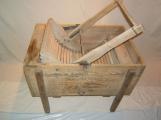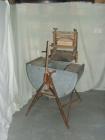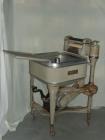14
When clean, the clothing was put through the wringer, to remove as much of the soapy water as possible. The wrung articles were dropped into the second tub which contained the cool rinse water. The plunger was then used again to force the rinse water to remove the excess soapy water. The wringer could be moved to have the clean clothes drop into a basket. This continued until all the sudsy clothing went through this process. Cost wringer $6.25.16
The evolution of the washing appliance was soon seen. The following are some of the innovative washing machines, still labour intensive but 'state of the art' in its time.The 'Laundry Maid' - "open type washing machine. Simply push the handle back and forth. The barred rubbing board, working on a corrugated surface, squeezes and rubs the clothes at the same time. Empties by plug on the side". In the 1901 T. Eaton catalogue "Dowswell washer" sold for $3.50.
18
Made of wood and can be seen in the 1895 Montgomery Ward Catalogue priced at $2.75. Also in the 1901 T. Eaton Co catalogue "Canadian washer" priced at $3.50. Note the wooden spokes as agitator.20
Very early washing machine - the lid was corrugated, which could be used as a wash board.22
This is a gas motor washing machine (minus the motor - likely utilized for another purpose, when the machine was replaced by a newer model?) It is an improvement in efficiency and esthetically built.24
Machine operated by gas motor was decidedly several 'notches' above hand operated washer. Note starter pedal.26
No dryer as we know it today but the trusty outdoor clothesline and nature's wind. It was a happy wash day that the wind blew in the right direction, drying the clothes giving off a wonderful fresh scent. The wind direction was important, if it blew straight on the result was less ironing, rather than twist around the clothesline itself to cause excessive wrinkles.Hanging clothes was an art! Undergarments were hung on the inside lines away from prying eyes. Each garment had a particular method to which it should hang, i.e. man's shirt hung upside down and pinned at the seams; pants were hung carefully from bottom of legs, the wet material having weight avoided excess ironing; socks pinned at the top opening, etc.






